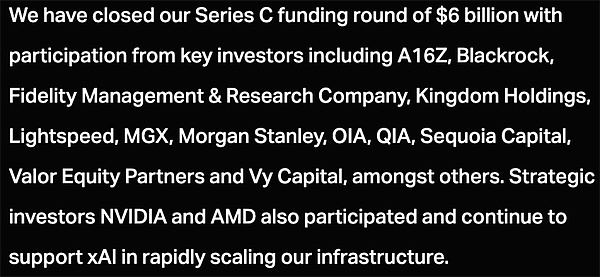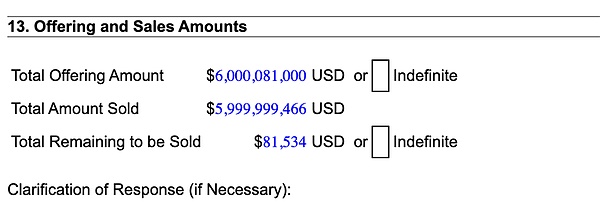Source: Zhidongxi
Raising $12 billion in less than 7 months, what level?
This is the latest battle report of xAI, the AI big model company founded by Musk.
Zhidongxi reported on December 24 that today, xAI announced that it has completed a $6 billion (about RMB 43.8 billion) Series C financing, with investors including A16Z, Blackrock, etc. Strategic investors Nvidia and AMD also participated and continued to support xAI's rapid expansion of infrastructure.

xAI disclosed that this round of financing will be used to further accelerate its advanced infrastructure, launch breakthrough products that will be used by billions of people, and accelerate the research and development of future technologies to achieve the company's mission of understanding the true nature of the universe.
Combined with the $6 billion Series B funding announced in May, this new funding brings xAI’s total funding to $12 billion (about 87.6 billion yuan). This means that xAI’s valuation has exceeded the previously rumored $50 billion, and is comparable to JD.com’s total market value of $52.6 billion. In terms of valuation, xAI has firmly established itself as the world’s largest model unicorn, second only to OpenAI.

Previously, the Wall Street Journal reported in November that xAI told investors that it had raised $5 billion in a round of financing, achieving a valuation of $50 billion (about 364.9 billion yuan), which is more than twice its valuation of $24 billion six months ago.
According to documents filed with the U.S. Securities and Exchange Commission on Thursday, investors donated at least $77,593 (a total of 97 people participated, but the documents did not disclose their identities).

Only investors who supported xAI in the previous round of financing were allowed to participate in this round of financing, the Financial Times reported. Investors who provided funds for Musk's acquisition of Twitter can get up to 25% of xAI's shares.
xAI has reportedly told investors that it plans to raise more funds next year.
xAI's most powerful model to date, Grok 3, is in training.
xAI is currently focused on launching innovative new consumer and enterprise products that will use Grok, Colossus and social platforms? to change the way people live, work and play.
01.Expanding the world's largest AI supercomputer,will expand to 200,000 GPUs
Musk founded xAI in July last year. Soon after, the company released its flagship generative AI model Grok. The model currently powers many features on the social platform ?, including chatbots available to ? Premium subscribers and free users in some regions.
According to xAI, since May this year, xAI has made significant technological progress and launched a number of key initiatives:
Colossus, xAI has established a decisive hardware advantage with the world's largest AI supercomputer, which uses NVIDIA's full-stack reference design and is equipped with 100,000 NVIDIA Hopper GPUs. Compared to typical multi-year industry timeframes, Colossus was fully operational in 122 days and was running workloads just 19 days after the first servers were delivered. Soon, xAI will double the scale of Colossus to a total of 200,000 NVIDIA Hopper GPUs using the NVIDIA Spectrum-X Ethernet networking platform.
Grok 2, xAI’s cutting-edge language model with state-of-the-art inference capabilities.
xAI API, giving developers programmatic access to its underlying models and built on a new custom technology stack, allowing for multi-region inference deployments for global low-latency access.
Aurora, xAI’s proprietary autoregressive image generation model for Grok, which enhances multimodal understanding, editing, and generation capabilities.
Grok on , using the platform to understand what's happening in the world in real time, has recently added new features to enhance the experience, such as web search, citations, and image generator Aurora.
Musk said the Memphis data center has the most powerful AI cluster in the world. xAI is training the next generation of Grok models in the Memphis data center.
The data center is currently powered in part by portable diesel generators, according to TechCrunch. In November, xAI received approval from the Memphis Regional Electric Power Authority to provide an additional 150MW of electricity, enough to power about 100,000 homes.
To win the agency's support, xAI promised to improve the quality of the city's drinking water and provide Tesla-made batteries to the Memphis power grid at a discount. But some residents criticized the move, saying it would put pressure on the power grid and worsen the air quality in the area.
Tesla is also expected to use the upgraded data center to improve its autonomous driving technology.
From an operational perspective, xAI has grown rapidly in the year since its founding, from a dozen employees in March 2023 to more than 100 today. In October, xAI moved into OpenAI's old corporate office in San Francisco's Mission neighborhood.
02.Full-scale pursuit of AI competitors,revenue of about $100 million this year
Musk is particularly focused on beating OpenAI.
He is one of the founders of OpenAI and left OpenAI in 2018 due to disagreements over the direction of the company. He argued in a previous lawsuit that OpenAI profited from his early involvement but violated its nonprofit commitment to make its AI research accessible to everyone. OpenAI responded that the allegations were unfounded.
According to the Wall Street Journal, xAI already provides customer support functions for SpaceX's Starlink internet service, and the startup is said to be in talks with Tesla to provide research and development services in exchange for a portion of Tesla's revenue.
Tesla shareholders oppose these plans. Some have filed lawsuits against Musk over his decision to start xAI, saying he diverted talent and resources from Tesla to what is essentially a competitor.
These deals, along with xAI's developer and consumer-facing products, have pushed xAI's annual revenue to about $100 million. By comparison, Anthropic is reportedly on track to generate $1 billion in revenue this year, while OpenAI aims to reach $4 billion by the end of 2024.
Grok has what Musk describes as a "rebellious streak" -- a willingness to answer "tough questions that most other AI systems refuse to answer," according to TechCrunch. For example, when told to be vulgar, Grok will happily comply with the user's request, saying some profanity and vulgar language that would not be heard on ChatGPT.
Grok itself is unwilling to cross certain boundaries and shy away from political issues. Musk has mocked ChatGPT and other AI systems for being too "woke" and "politically correct," though. He also called Grok "truth-seeking at its best" and less biased than competing models.
Grok has been gradually integrated into ? over the past year. At launch, Grok is only available to ? users, and developers must have enough skills to get the "open source" version up and running.
After integrating the image generator Flux, Grok can generate images on ? (controversially, without guardrails), analyze images, and summarize news and trending events (but not perfectly).
Reports indicate that Grok may handle more ? functions in the future, from enhancing ?'s search capabilities and account profiles to helping with post analysis and reply settings.
xAI is chasing competitors like OpenAI and Anthropic to stand out in the generative AI race. The company launched an API in October that allows customers to build Grok into third-party apps, platforms, and services, and just launched a standalone Grok iOS app to test users.
Musk insists it's not a fair fight.
In the lawsuit against OpenAI and its close partner Microsoft, Musk's lawyers accused OpenAI of "actively trying to eliminate competitors such as xAI by forcing investors to promise not to provide it with funding." Musk's lawyers said OpenAI also unfairly benefited from Microsoft's infrastructure and expertise, which was a "de facto merger."
Musk often said that ?'s data gave xAI an advantage over its competitors. Last month, ? changed its privacy policy to allow third parties, including xAI, to train models on ?'s posts.
According to the vision outlined by xAI, its models will be trained on data from Musk's various companies, such as Tesla and SpaceX, and its models can then improve the technology of these companies.
03.Conclusion: Intensive outbreak of financing in the global AI competition
xAI is not the only AI big model company that has raised huge funds.
Anthropic, a large-scale model unicorn in the United States, recently received $4 billion in financing from Amazon, bringing its total financing to $13.7 billion and its valuation to more than $18 billion (about RMB 131.4 billion).
An even larger super unicorn is OpenAI, which announced in October that it had received $6.6 billion in financing, bringing its total financing to $17.9 billion and its post-investment valuation to $157 billion (about RMB 114.59 billion). In November this year, OpenAI was exposed to have received $1.5 billion (about RMB 10.9 billion) in investment from Japan's SoftBank Group.
PitchBook data shows that large transactions such as OpenAI and Anthropic have driven AI venture capital activities to more than 2,000 transactions in the third quarter of 2024, with a total of $31.1 billion.
In the past month, domestic large model companies have also released financing news intensively: On December 11, Beijing large model startup Mianbi Intelligence announced that it had recently completed several hundred million yuan of financing; On December 17, Beijing large model unicorn Zhipu announced that it had recently completed 3 billion yuan of financing; On December 18, Beijing AI video generation startup Aishi Technology announced that it had completed nearly 300 million yuan of financing; On December 23, Shanghai large model unicorn Jieyuexingchen was exposed to have completed several hundred million US dollars of Series B financing.
2024 is coming to an end, but with the help of the hot financing wave, the competition for large models in the new year seems to be more intense.
 JinseFinance
JinseFinance
 JinseFinance
JinseFinance JinseFinance
JinseFinance Davin
Davin Coindesk
Coindesk Others
Others Coindesk
Coindesk Cointelegraph
Cointelegraph Cointelegraph
Cointelegraph Cointelegraph
Cointelegraph Cointelegraph
Cointelegraph